

Note: This article was originally written in 2005. It was updated and reformatted in 2021.
Few gangsters have cast a greater shadow on American society than Albert Anastasia of Brooklyn. For much of three decades, the man who was called "The Mad Hatter" and "The Lord High Executioner" helped to shape the organized underworld in the United States.
Though history has focused on his explosive temper and his legendary short fuse, Anastasia was arguably a criminal visionary. With Brooklyn friends Joe Adonis and Vincent Mangano, Anastasia brought a never-before-seen level of organization to waterfront labor racketeering. Over time, he came to control the International Longshoremen's Association and with it the entire Brooklyn waterfront.
Just as Anastasia began to set his sights on bigger and better rackets, he came into conflict with a rival, just as ambitious and perhaps a bit more ruthless than Anastasia himself. A behind-the-scenes clash with Vito Genovese preceded Anastasia's death on a barber shop floor in 1957.
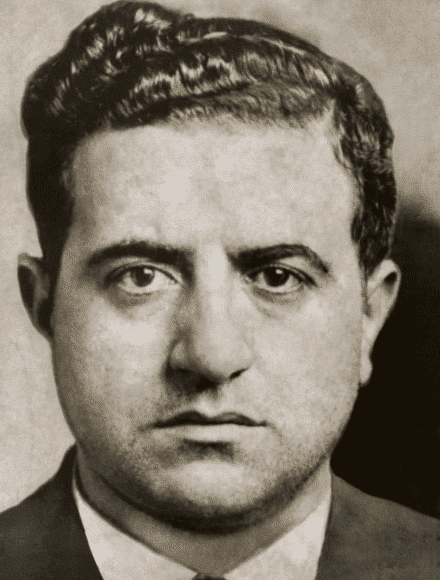
Anastasia
Umberto Anastasio was born to Bartolomeo and Marianna Polistina Anastasio in Tropea, a community in the Calabria region of southern mainland Italy. The date of his birth has been variously reported as 26 February 1902, 26 September 1902 and other dates in 1903. The September 1902 date is carved into his gravestone.
The Anastasio family grew to include nine boys and three girls. One of the boys and two of the girls died at a young age. The family patriarch, a railroad worker, died some time before the start of the Great War in Europe.
As teenagers, Umberto and his brothers Giuseppe, Gennaro and Antonio found work as deck hands on tramp steamers. They sailed the Atlantic until deciding, apparently at different dates, to "jump ship" in New York City.
Umberto slipped away from his work on the steamer Sardegna and settled in Brooklyn around September 12, 1917. There he set to work as a longshoreman and came into daily contact with the toughs and racketeers of the waterfront.
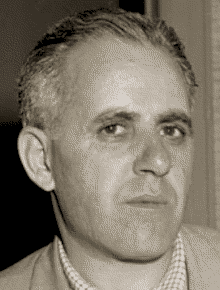
'Tough Tony'
Umberto's brothers Giuseppe, Gennaro and Antonio (later known as "Tough Tony") joined him at the Brooklyn docks. Another brother, Salvatore Anastasio, moved to New York and entered the Roman Catholic priesthood.
In the 1920s, Umberto adjusted his identity. He began to use the Anglicized first name of "Albert." And he also changed the final vowel of his surname from an O to an A.
The reason traditionally given for his adoption of the name "Anastasia" is that he had deliberately chosen a life of crime and did not want to bring disgrace on the rest of his family. But that rationale is difficult to accept. If Anastasia wanted to distance himself from his kin, he could have done so more effectively by chosing an entirely different surname. And, in fact, it appears he maintained close and visible relationships with his brothers in America after the name change. Their family bond was widely known.
It seems more plausible that Anastasia, like other gangsters of the period, used variant spellings of his name to create minor headaches for law enforcement. The "Anastasia" spelling might have stuck merely because that name was constantly in the American news in the 1920s.
During the decade, an American widow named Nance Leeds married Prince Christopher of Greece. The new princess took the Greek name Anastasia because it sounded similar to her original given name. As an American link to royalty, "Princess Anastasia" of Greece and her family were celebrated in the media. By the middle of the 1920s, another "Princess Anastasia" was in the news. She was the daughter of assassinated Czar Nicholas II of Russia. It was believed by some that the Czar's daughter survived the violent takeover of the Bolsheviks and settled in Germany.
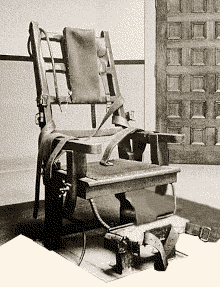
Sing Sing's electric chair
In March of 1921, Albert Anastasio (apparently still ending his name with an O at this time) and his buddy, fellow Calabian Joseph Florino, were formally charged with first-degree murder. The two were indicted for the May 16, 1920, fatal shooting of an Italian longshoreman.
The victim was initially named "Joe Turino" in the newspapers, and later FBI reports referred to him "George Turello." The deceased's actual name appears to have been Joseph Terella.
After Terella's death, Albert fled Brooklyn and set himself up in Providence, Rhode Island. New York authorities were able to track him there and have him returned for the action of the grand jury.
The defendants were convicted at trial in May. Anastasia and Florino were sentenced to death by electrocution. They were incarcerated in the "death cells" at Sing Sing Prison in Ossining, New York.
According to legend, Anastasia allies then went to work ensuring a successful appeal of the verdict by forcing state witnesses to change their stories and by making uncooperative witnesses disappear. However, the legal appeal appears to have been based on new information, linking a key state witness with defendant Florino, as well as new eyewitness testimony provided by Anastasia ally John Giustra.
A retrial was granted in June 1921. The new evidence that had surfaced decimated the state's case. Prosecutors did not retry Anastasia and Florino. In spring of 1922, they were discharged.
Anastasia walked out of a Sing Sing "death cell" and back into a free life. The experience made him an instant underworld celebrity.
Anastasia became adept at thwarting justice. His criminal record from 1922 on is largely a collection of unsuccessful prosecutions.
In August of 1922, he was arrested in connection with a recent homicide. The charge was dropped for lack of evidence. In April of the following year, police nabbed Anastasia for felonious assault. After the arrest, the witnesses against him suddenly changed their stories, and he was freed.
In the early 1920s, underworld feuds raged in New York City. Many small battles were fought in the streets of Brooklyn and on Manhattan's Lower East Side.
Much of the violence of the period resulted from conflicts among bootlegging and other racketeering groups. Some additional bloodshed was due to growing pains of the Sicilian-American Mafia in New York.
One conflict erupted when Brooklyn-based Mafia boss of bosses Salvatore D'Aquila worked desperately to hold onto his position after the early prison release of former supreme boss Giuseppe Morello.
Further friction occurred as the Sicilian underworld in New York (and across the country) absorbed Calabrian and Neapolitan underworld networks. A somewhat liberal-minded anti-D'Aquila Mafia organization commanded by Giuseppe "Joe the Boss" Masseria appeared to benefit from alliances with a Calabrian organization in Brooklyn and Neapolitan Camorristi throughout the metopolitan area. Other Brooklyn Calabrians, including Anastasia and Florino (and Biagio Giordano, who was perhaps their underworld superior), were welcomed into the more conservative D'Aquila Mafia Family.
Anastasia's level of involvement in the feuds is uncertain. A newspaper report from late April 1923 noted that he and Biagio Giordano were shot while driving on Sackett Street. Giordano succumbed to his wounds. The press account noted that the Anastasia had been taken into custody in connection with the earlier murder of Sicilian mafioso Vincenzo Busardo of Bensonhurst and later released for lack of evidence.
Busardo had been connected with another murder, and police assembled evidence of a vendetta feud that accounted for at least five deaths. Busardo was believed personally responsible for attacks against several of Anastasia's close associates.
Anastasia was not available to continue the feud. In June of 1923, he was arrested for carrying a revolver. He was convicted in July and sentenced to three years at Blackwell's Island Penitentiary. By the time he was released, D'Aquila remained a boss in title only. The real power in New York City rested with anti-D'Aquila leader Giuseppe Masseria.
By the later 1920s, Anastasia was well acquainted with New York area gangsters like Giuseppe "Joe Adonis" Doto, Guarino "Willie Moore" Moretti and Anthony "Augie Pisano" Carfano. It appears likely that he was also acquainted with Brooklyn Calabrian gang leader Francesco "Frankie Yale" Ioele.

Brooklyn docks
Anastasia's major criminal interest was at the waterfront. Apparently using a string of homicides and resulting terror as his tools, he gained control of union locals of the International Longshoremen's Association and could extort regular payments from both dock workers and their employers.
As 1930 arrived, another underworld war began. "Joe the Boss" Masseria had eliminated D'Aquila in 1928 and became the U.S. Mafia's new boss of bosses. Rather than learn from D'Aquila's abuses of power, Masseria began following in his predecessor's footsteps. He started to influence matters in other crime families and in other regions. Rather than strengthen his position as underworld leader, his meddling caused many American mafiosi to oppose him.
Masseria imposed leadership changes on families in Detroit, Brooklyn and the Bronx. He took sides in an underworld conflict in Cleveland and also backed Al Capone in his war against the established Sicilian Mafia family in Chicago.
Backed by mafiosi in Detroit, Philadelphia, Buffalo and Chicago, a Brooklyn group, which originated in the Sicilian town of Castellammare del Golfo, rose in rebellion under the leadership of Salvatore Maranzano.

Lucania
Salvatore "Charlie Luciano" Lucania and his allies were important figures in the Masseria outfit. It is not entirely clear for whom Anastasia fought during the war. At times, he may not have been certain of that himself. The former D'Aquila Crime Family, of which Anastasia was a member, had suddenly become a Masseria ally under the leadership of boss Manfredi Mineo. But the old D'Aquila organization then adopted an anti-Masseria stance following the late 1930 murder of Mineo and the accession of Frank Scalise.
As the "Castellammarese War" turned against Masseria, Lucania and other Masseria lieutenants plotted against their boss. Mafia chronicler Nick Gentile recalled that the lieutenants acted against Masseria because, despite their mounting war casualties, he refused to allow them to carry firearms. Whatever their motivation, in April 1931 they set up a hit on Joe the Boss.
Some believe Anastasia was one of the gunmen who, at Lucania's behest, entered Gerardo Scarpato's Nuova Villa Tamaro restaurant at Coney Island and pumped lead into Masseria on April 15. Murder Inc. turncoat Abe Reles proposed this idea, saying Anastasia, operating on orders from Lucania, killed Joe the Boss.
But the scenario offered by Reles is a strange and unbelievably convoluted one. It involved a secret plot by Masseria to murder his underling Lucania, Lucania's discovery of the plot and preemptive strike against the boss. To involve Anastasia, Lucania would have needed to enlist the support of the leadership of a wartime enemy crime family - the Scalise group. He certainly would have had simpler options.
With Masseria eliminated, Maranzano immediately declared himself boss of bosses. When he was seen plotting against other bosses, in the pattern of his predecessors, some of his allies conspired in his September 1931 assassination.
A "Commission" of top bosses was formed in order to resolve inter-family disputes, and the problematic old boss of bosses system was discarded.

Buchalter
Anastasia emerged as one of the most powerful Calabrian mobsters within the American Mafia. He served as underboss to a sprawling Brooklyn-Bronx Crime Family led by Vincent Mangano, who replaced Frank Scalise as boss of D'Aquila's old organization.
According to legend, Anastasia also served as an intermediary between Mafia leaders and a Brooklyn-based enforcement wing that became known as Murder Inc. (The name of the enforcement group was apparently taken from a book written by former prosecutor Burton Turkus. However, Turkus clearly intended to apply the nickname "Murder, Inc." to the entire nationwide underworld syndicate he uncovered. He did not use it as a proper name for the enforcement group, but occasionally referred to this arm as "Brooklyn Inc.")
Often described as a group of professional killers on retainer, Murder Inc. was overseen by non-Mafia racketeer Louis "Lepke" Buchalter. Anastasia's supposed leadership role in the group gave him the nickname of "Lord High Executioner."
Law enforcement continued to have trouble getting charges to stick to Anastasia through the early 1930s.
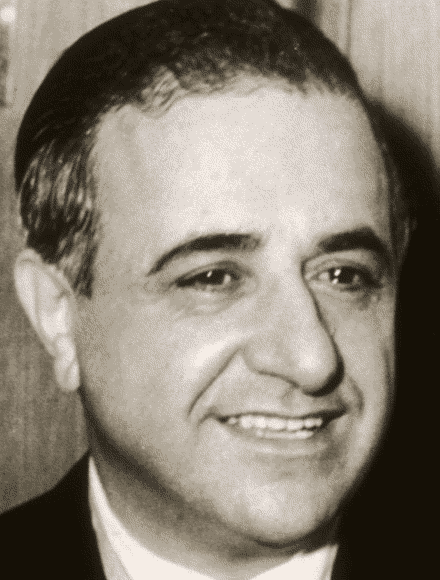
Anastasia
He was suspected of involvement in the kidnapping of Isidore Juffe in 1932, but his role could not be proven in a courtroom. He was arrested twice in August of 1932 - first on suspicion of committing a Brooklyn homicide with an ice pick and then for consorting with known criminals. He was discharged both times.
One of those cases involved the icepick killing of Pittsburgh Mafia boss John Bazzano, a Calabrian. An underworld tribunal found Bazzano guilty of the improper murders of several Neapolitan gangsters in his organization and condemned him to death. Vito Genovese, then second in command in the Lucania (former Masseria) organization and the top ranking Neapolitan in the American Mafia, initially suspected Anastasia of involvement in the incident as well. But Anastasia managed to convince Genovese that he had nothing to do with it.
In August of 1933, witnesses identified Anastasia as the killer of a Brooklyn laundryman. Those witnesses later changed their stories, and Anastasia was let go.
While the police had a difficult time holding onto Anastasia, a Canadian-Italian woman managed to land him for good.
Elsa Bargneti, who was born in Ontario, Canada, in 1914, entered the United States through Detroit in 1934 and made her way to Brooklyn. She and Anastasia were married two years later, when he was thirty-six and she was twenty-four. The couple had a son a year later. He was named Albert Jr.
The year 1939 turned out to be a troubling one for the members of the hit squad known as Murder Inc. The murder of Peter Panto, a crusader against racketeer involvement in organized labor, caused much law enforcement energy to be focused on the group of professional killers. Abe Reles, Murder Inc. member, was charged with Panto's murder and decided to betray his underworld associates rather than fry for the crime.
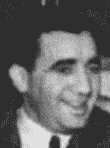
Abe Reles
Reles' testimony helped police to more fully understand dozens of previously unsolved murders and provided a window into the leadership roles of Anastasia and Buchalter. Investigators were able to link Anastasia in particular to the killing of Panto and to the assassination of Teamster union official Morris Diamond.
With Reles as a witness, Brooklyn District Attorney William O'Dwyer was able to win convictions against a number of mob hit-men. Buchalter would eventually get the chair for his involvement in the murder for hire organization.
O'Dwyer felt certain of winning an important conviction against Anastasia as well. His feelings changed, however, when Reles was found dead five stories below his room window at the Half Moon Hotel in Coney Island. Reles had been held at the Half Moon under armed guard while awaiting trial. A few tied-together bedsheets draped out the window suggested that Reles might have been trying to escape from police custody. But the distance his body traveled away from the hotel wall indicated that he had been thrown.
Legends say Anastasia had managed to get to Reles even while Reles was guarded by lawmen.
O'Dwyer's case against the Lord High Executioner collapsed. But the Brooklyn D.A. kept the pressure on. The Mafia Commission reportedly was forced to disband Murder Inc. and find other means of organizational discipline, and Anastasia was forced to change addresses for a while.
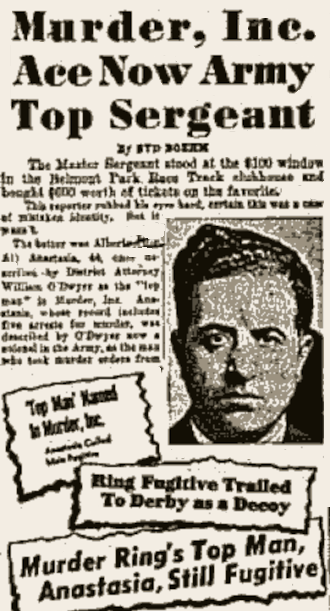
Anastasia becomes
an army sergeant
The beginning of American involvement in the Second World War provided Anastasia with a means to vanish from New York for a while and simultaneously improve his image.
He enlisted in the armed forces on May 18, 1942. With his experience on the Brooklyn docks, he proved valuable to the military as an instructor. He was made a technical sergeant and assigned to the education of military longshoremen at Indiana Gap. Pennsylvania.
The military turned out to be Anastasia's route to U.S. citizenship.
He took advantage of a special act of Congress, which granted speedy naturalization to aliens serving in the American armed forces, to become a citizen on June 29, 1943. He didn't mention any of his previous run-ins with the law on his citizenship application.
At the end of the following year, the army discharged him because he was overage. He was nearly forty-three at the time.
In the mid-1940s, Anastasia decided to move away from Brooklyn and follow his longtime friend Joe Adonis to the "country,"" setting of Fort Lee, New Jersey. The Brooklyn home held in the name of his wife was sold for $25,000. The Anastasias built a new, thirty-five-room, five-bathroom house, valued at more than $75,000 at 75 Bluff Road in Fort Lee. The property was put in the name of Albert and Elsa Bargneti. The hillside mansion, just around the corner from Adonis's home, overlooked rolling hills and the Hudson River.
In October 1945, Anastasia showed the degree of his influence over New York's longshoremen. A strike, relating to an inter-union power struggle, crippled the city's docks from October 1 to October 22. Anastasia then assembled his Brooklyn allies and brought them back to work. As the Brooklyn docks opened again, the strike collapsed, and the entire New York waterfront was opened for business.
As the 1950s opened, Anastasia was a focal point for state and federal racketeering investigations. Government officials named Anastasia as one of the leading figures in a national crime syndicate that ran rackets in major U.S. cities and sentenced its own members to death for disobedience.
Anastasia's name was in the newspapers regularly, causing a great deal of concern for his underworld partners. He was labeled as the Mafia's chief thug, as a smuggler of heroin, as a corruptor of the labor movement.
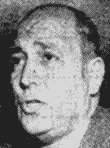
Moretti
At the same time, Anastasia's old buddy Willie Moretti was getting himself into trouble. According to legend, Moretti's mind was affected by syphilis, and he was talking too much, about too much, to too many people. With government investigators calling mobsters to televised hearings all across the country, Moretti was becoming a great liability.
Curiously, Anastasia and Moretti were reportedly trusted with a sensitive assignment in October 1951. The syndicate wished to provide a handsome payoff to a jailed bookmaker to ensure that he would not rat out his underworld colleagues. Anastasia and Moretti were asked to take the money to the bookmaker's representative. Moretti's "thing" was gambling (he also dabbled in entertainment, reportedly helping Sinatra become a star), so he was a natural choice. But Anastasia's inclusion in the assignment smells like a setup.
Some of the money disappeared on the way.
Anastasia insisted to the bosses on the Commission that he knew nothing about the missing money. The Commission, dominated at the time by a conservative Sicilian faction, decided to give him the benefit of the doubt, just for the moment.
On Thursday, Oct. 4, 1951, Anastasia reportedly was warned to stay away Joe's Restaurant, on Palisade Avenue in Cliffside Park, New Jersey, a short distance from the Anastasia home in Fort Lee. Late in the morning, Willie Moretti was killed at that restaurant. Some sources suggest that Anastasia was forced to take a role in setting up the murder of his old friend. Anastasia reportedly asked for and was granted the use of Moretti's driver/bodyguard for the day.
Four men, already at the restaurant when Moretti arrived alone, invited him to their table. The group joked in Italian and laughed for a while together. Two of the men then drew handguns and fired into Moretti's head and face.
According to the press, the old chief of Murder Inc. received word that he should retire at once or he would be next. It seems Anastasia looked into the possibility of retiring to the resort town of Hot Springs, Arkansas. But the community convinced him he was not wanted there.
Apparently deciding against retirement, Anastasia opted instead to improve his stature in the Sicilian-Italian underworld. He moved against his conservative family bosses, the Mangano brothers, and seized control of the organization.
Philip Mangano was found dead in a Canarsie swamp. Boss Vincent Mangano was not found at all. Ever. Anastasia became boss of the family.
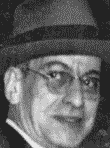
Tony Strollo
His new prestige as boss coupled with his influence at the Brooklyn docks made him a considerable force in organized crime. He also had investments in clothing companies and a small interest in garment workers unions. Through his brother Antonio - a longshoreman union official known at the time as "Tough Tony" - Anastasia was gaining influence with the Manhattan dockworkers. With ally Anthony "Tony Bender" Strollo, a capo in the Lucania organization then commanded by Frank Costello, he was also becoming a force on the New Jersey shore.
Left unchecked, Anastasia might have come to own all of the New York-New Jersey waterfront and to threaten the lucrative garment district rackets jealously guarded by other crime families.
On the Commission, Anastasia became a strong supporter of Frank Costello. Costello had become the boss of the old Masseria-Lucania family after Lucania was deported and underboss Vito Genovese exiled himself to Italy to avoid a U.S. murder prosecution.
The new Fort Lee home turned out to be a problem for Anastasia. He could not have afforded to build such a structure on the income he claimed on his tax documents. Federal Treasury agents hoped to succeed where local and state law enforcement officials had failed so many times before.
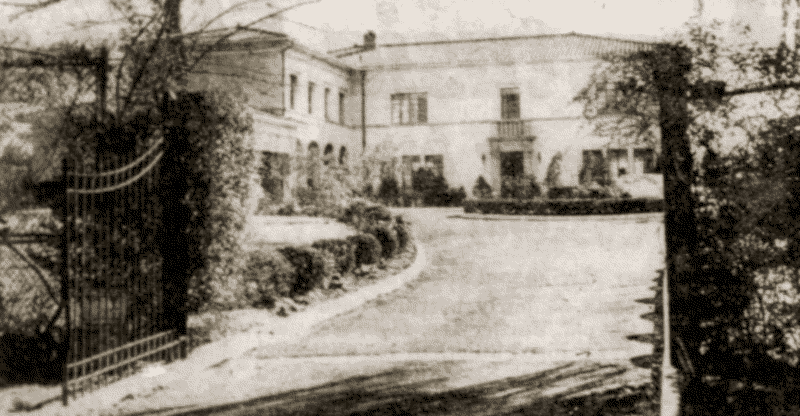
Anastasia home in Fort Lee (NY Daily News).
A case for tax evasion was assembled against Anastasia beginning in 1948. At issue were his tax returns for the years 1947 and 1948. During that period of time, Anastasia paid $2,788 in taxes on a reported income of $18,769. The government estimated that it was owed $14,521 in taxes on income that must have been at least $51,075.
One of the more damaging witnesses against Anastasia was a Fort Lee plumber/pipefitter named Charles Ferri. According to Ferri, he did $8,700 worth of work on Anastasia's home. He linked Anastasia directly to payments for the work by noting that he was handed $1,000 from Anastasia himself.
One of the scheduled witnesses in the federal trial did not appear. Anastasia bodyguard Vincent Macri, expected to testify against his boss, was found dead April 25, 1954, in the trunk of his automobile parked in the Bronx.
The jury in the case decided it was hopelessly deadlocked on November 21, 1954, and a mistrial was declared by Judge Albert E. Mondarelli.
The Treasury reloaded and took another shot at Anastasia in spring of 1955. Oddly, Charles Ferri could not be located. After the first trial, he and his wife quickly left Fort Lee and headed south, settling in Miami, Florida. But, even when tracked to the Sunshine State, the Ferris could not be found.
Investigators did find blood spatters in the Ferri's Miami home. They concluded that Anastasia, free on $10,000 bail, was using his favorite legal defense technique.
Just as the second tax evasion trial was set to begin, federal prosecutors received a surprise. Anastasia's attorney Anthony A. Calendra of Newark announced that his client had decided to plead guilty to tax evasion.
The move was a strange one. The Treasury had managed only a mistrial in the first go-round, and its case had not improved with the loss of Ferri. Perhaps things in New York were getting a little hot for Anastasia, and he needed an extended vacation.
Judge Thomas M. Madden imposed a sentence of one year in jail and a $20,000 fine. The punishment was considerably shorter than the possible maximum of five years per count. On June 14, 1955, U.S. Marshal Joseph Job took Anastasia by airplane to federal prison at Milan, Michigan.
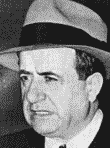
Anastasia
While he was fighting the IRS, Anastasia came under attack from the INS - the Immigration and Naturalization Service of the federal Justice Department.
The first round of that bout was won by the government. On April 27, 1954, federal district Judge William A. Smith signed a denaturalization order against Anastasia. It was decided that the longtime racketeer had lied about his background in his citizenship application. Assistant U.S. Attorney Pierre Garvan was forced to wait for the appeals process to run its course before beginning a formal deportation proceeding.
Three months after he entered prison on the tax evasion conviction, Anastasia received word that the U.S. Circuit Court of Appeals in Philadelphia had sided with him. By a 2-1 ruling, the court reversed Judge Smith and restored Anastasia's citizenship.
Efforts to remove Anastasia from the United States continued into 1956. On May 14 - a month and a half after his early release from Milan - the United States Supreme Court refused to hear the case, essentially backing the decision of the Appeals Court.
Anastasia's celebratory mood was dampened by news of the death of his brother Giuseppe Anastasio. Giuseppe had risen to the position of pier hiring boss. He was a popular man at the docks. Anastasia saw to it that his brother had a lavish funeral. The cortege was said to be a mile long.
In 1957, the Mafia Commission became aware that Anastasia's crime family was selling Mafia memberships. Underboss Frank Scalise was believed to be filling his pockets through the practice. The sale of membership was expressly forbidden, as it exposed the organization to untrustworthy individuals and to law enforcement infiltration.
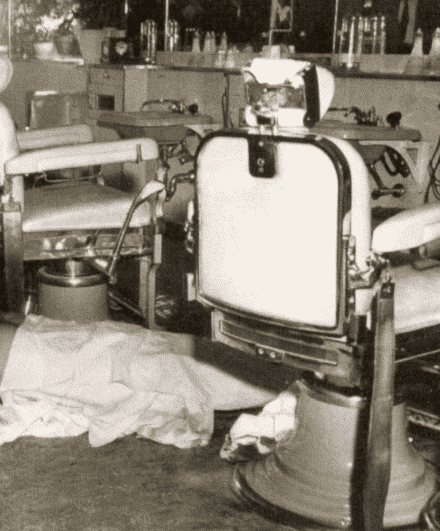
Scene of Anastasia's murder
It appears that Anastasia attempted to rectify the situation himself by ordering the execution of Scalise. Because Scalise was a friend of Luciano and the recently deported Adonis, Anastasia reportedly sent word to his two old colleagues in Italy before the deed was done.
Mafiosi have never been particularly strong in the forgive-and-forget department. Though Anastasia was taking proper corrective action, the Scalise problem - coupled with the earlier Moretti problem - left Anastasia with two black eyes. Anastasia was momentarily weakened.
Anastasia buddy Frank Costello was the target of an assassination attempt in the same year. Costello survived, as the assassin's bullet, fired at his head, just grazed his scalp.
Some in the city believed that the botched hit at Costello's apartment house was the result of a falling out between Costello and Anastasia. Those in the know suggested that it merely indicated that patience of Vito Genovese, who had returned to the U.S. years earlier, was at an end.
Genovese apparently was ready to assume control of the organization and decided that a hit was the easiest way. Even the botched hit turned out to be sufficient. Costello got the message, along with a new part in his hair. He retired as family boss. Genovese took over the family.
Anastasia, devoted friend of Costello, became instantly opposed to Genovese on the Commission and vaguely swore revenge on whoever was responsible for the hit on Costello.
At 10:20 in the morning on Oct. 25, 1957, Anastasia stopped into the barber shop at the Park Sheraton Hotel (the same hotel at which Arnold Rothstein was killed years earlier) for a shave and haircut. He frequented the establishment operated by Arthur Grasso. That morning, he sat in the fourth of twelve barber chairs and leaned back as barber Joseph Bocchino placed a hot towel on his face.
Two masked gunmen burst into the shop and unloaded handguns into the fifty-five-year-old Anastasia's body. The mob boss was hit in his head, back, right hip and left hand. Witnesses said he lunged from the chair and attacked the reflection of his attackers in the mirror in front of him before collapsing dead in a pool of blood on the floor.
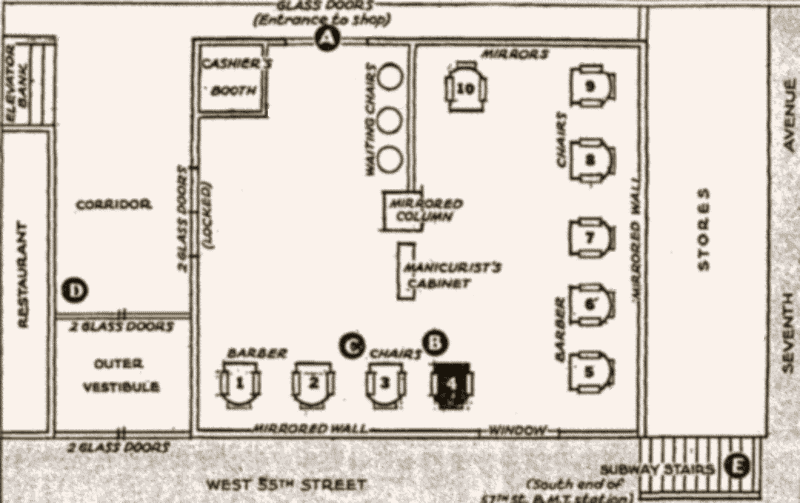
Diagram of barbershop (NY Times)
Anastasia had once slipped free of the electric chair only to meet his end in a barber chair.
Police investigators puzzled over the absence of Anastasia's driver and bodyguard Anthony Coppola at the time of the boss's murder. Coppola would say nothing to police except that he was at his home in Fairhaven, New Jersey, when he learned of Anastasia's death. Police held Coppola in custody as a material witness.
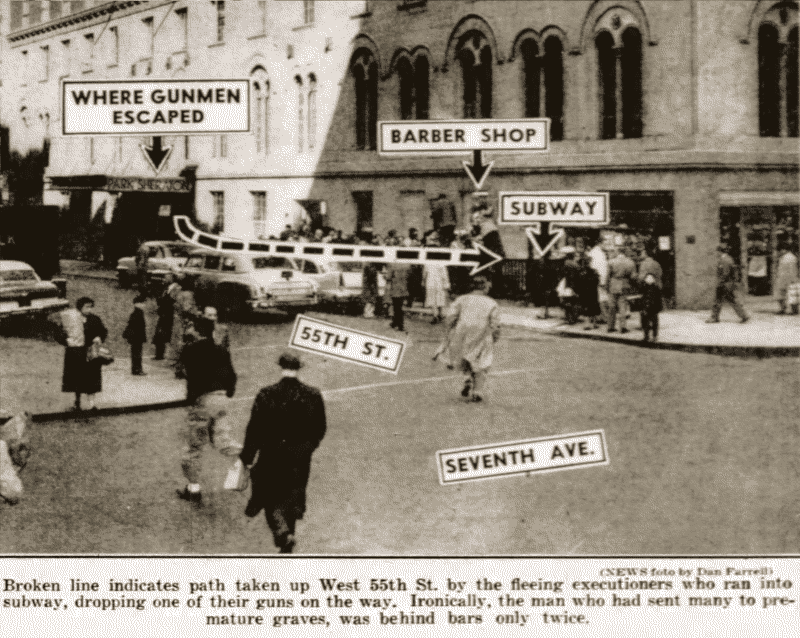
Route taken by the killers (NY Daily News)
With Anastasia responsible - directly and indirectly - for so many deaths, vendetta was certainly a possible motive for his assassination. Underworld competition was another possibility. Police investigators set to the task of sorting through the long list of the mob boss's enemies.
Eventually, the story of the Anastasia hit came together. It suggested that Genovese cultivated a momentary alliance with Commission members Joe Bonanno and Joe Profaci and Anastasia's Sicilian underboss Carlo Gambino, in order to eliminate Anastasia.
According to some legends, the job of assassinating Anastasia was given to the Profaci Crime Family. Some say Profaci assigned the task to a group including "Crazy Joe" Gallo and his brothers. Gallo, who subsequently led a revolt within the Profaci-Magliocco-Colombo family, seemed to admit involvement in the assassination later in his life.
In an alternative story, the Commission assigned the Anastasia killing to Joe Biondo, a member of Anastasia's own family. Biondo then directed members of his crew to eliminate the boss.
Some in the press theorized that Anastasia had fallen victim to his own ambition, running into a conflict over the numbers racket with Vito Genovese or over garment district rackets with Johnny Dioguardi. Some felt Anastasia was bumped off by an Irish mob looking to establish its influence along the docks or by a young faction in the Mafia trying to wipe out the old guard.
An intriguing speculation published in New York newspapers in January 1958 involved Anastasia being disciplined for attempting to move into Havana gambling without permission from Santo Trafficante (Tampa boss) and Meyer Lansky, who controlled that racket and served as a conduit for the investments of U.S. Mafia families. Anastasia reportedly met with representatives of the Cuban government just before meeting his end.
One simple theory seemed to capture the truth: Anastasia had gotten too big.
With Anastasia gone, Gambino became boss of the family that still bears his name. Biondo became his underboss.

Anastasia's body is removed (NY Daily News).
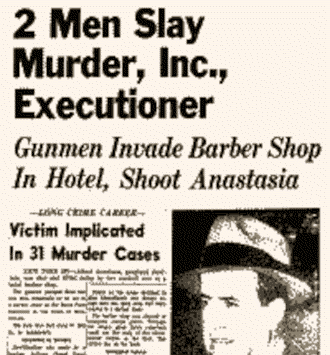
Anastasia's murder was front page news around the country
There was no Mass of Christian Burial for Anastasia. His family did not request one, feeling that it would be inappropriate considering his life of crime and his unrepentant nature. Thirty murders were attributed to Anastasia. The Murder Inc. organization he helped oversee was believed responsible for many more.
A poorly attended Sunday night wake was held in Parlor C on the second floor of Andrew Torregrossa's funeral home at 1305 Seventy-ninth Street in Brooklyn. Police were keeping an eye out for underworld characters who might choose to pay their respects. They identified only Augie Pisano.
Early the next morning, the press noted that William V. Bradley and Thomas W. Gleason, officials of the International Longshoremen's Association, showed up to pay their respects. Neither man would speak with reporters.
A simple ceremony was conducted in front of an inexpensive coffin (the press said it cost $900, in contrast with the many thousands of dollars spent on brother Giuseppe's coffin). Elsa wept loudly and nearly collapsed. She was led to a chair by Albert Jr., then in his twenties and recently graduated from college. Father Salvatore Anastasio prayed over his brother's corpse and the placed two rosaries in the dead man's hands. The priest did not travel to the cemetery.
The coffin was closed at 10:40 a.m. and a small crucifix was placed on it. The funeral cortege consisted of one car of flowers, the hearse and four cars for family members.
Anastasia could not be buried in a Catholic cemetery. He was interred in Brooklyn's Green-Wood Cemetery.
In February 1958, Elsa Bargnesi Anastasia left the family home in Fort Lee, New Jersey, and returned to Canada. Reporters located her at a large, two-story brick house in the North End neighborhood of Toronto's North York suburb. Her decision to leave was apparently a hasty one. On March 10, 1958, a Newark, New Jersey, court dismissed her application for U.S. citizenship because she did not appear for a hearing.
"Tough Tony" Anastasio remained a force on the New York waterfront until his death after a heart attack on March 1, 1963.